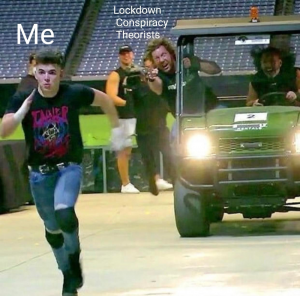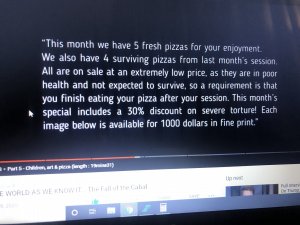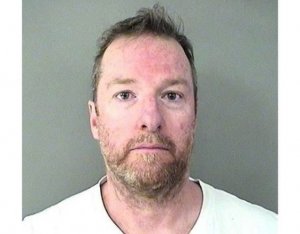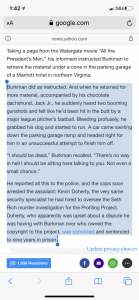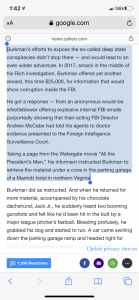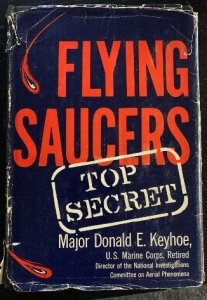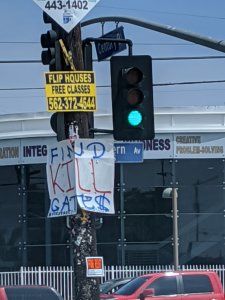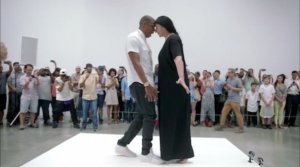March 2011
People are searching for answers in the aftermath of the 2011 Sendai Earthquake and Tsunami, the predictions of Edgar Cayce one avenue to explore.
Edgar Cayce coined the term Earth Changes, a reference to a series of cataclysm events which he prophesied would take place - including the Earth shifting on its axis, and most of California dropping into the Pacific Ocean following a catastrophic earthquake.
Some of Cayce readings allude to massive Earth changes - perhaps in conjunction with a pole shift - in the 1930s, 1960s, or 1990s. Cayce followers have developed several creative ways of interpreting such passages, although some were disappointed with the failure of 1998 to bring either the rising of Atlantis, the sinking of California, or the Second Coming of Christ. Other predictions were about dramatic changes in the Earth's surface in the period from 1958 to 1998 due to a tilting in the Earth's rotational axis which would begin in 1936.
The first sign of this change in the Earth's core would be the "breaking up of some conditions" in the South Pacific and "sinking or rising" in the Mediterranean or Etna area. Cayce forecast that, by the end of the century, New York, Los Angeles and San Francisco would be destroyed. He said that "the greater portion of Japan must go into the sea" at this time, and that northern Europe would be "changed as in the twinkling of an eye."
In 1941, Cayce predicted that lands would appear in the Atlantic and the Pacific in the coming years, and that the coastline now of many a land will be the bed of the ocean. Even many of the battlefields of 1941 will be ocean, will be the sea, the bays, the lands over which the new order will carry on their trade as with one another.
He warned: Watch New York, Connecticut and the like. Many portions of the east coast will be disturbed, as well as many portions of the west coast, as well as the central portion of the United States. Los Angeles, San Francisco, most of all these will be among those that will be destroyed before New York, or New York City itself, will in the main disappear. This will be another generation though, here; while the southern portions of Carolina, Georgia, these will disappear. This will be much sooner. The waters of the Great Lakes will empty into the Gulf of Mexico.
There will be the upheavals in the Arctic and in the Antarctic that will make for the eruption of volcanoes in the torrid areas, and there will be the shifting of the poles. The Earth's axis would shift by 2001.
Strifes will arise through the period. Watch for them near the Davis Strait between Greenland and Canada in the attempts there for the keeping of the life line to land open. Watch for them in Libya and in Egypt, in Ankara and in Syria, through the straits about those areas above Australia, in the Indian Ocean and the Persian Gulf.
By this time, he indicated, a New Cycle would begin.
Edgar Cayce's Biography
1877 to 1920: Kentucky period
Edgar Cayce was born into a farming family on March 18, 1877 near Beverly, seven miles (11 km) south of Hopkinsville, Kentucky.
In December 1893, the Cayce family moved to Hopkinsville, Kentucky and occupied 705 West Seventh, on the south-east corner of Seventh and Young Street. During this time, Cayce received an eighth-grade education; discovered his spiritual vocation;[4] left the family farm to pursue various forms of employment (at Richard's Dry Goods Store and then in Hopper's Bookstore, both located on Main Street).
Cayce's education stopped with the ninth grade because his family could not afford the costs involved.[3] A ninth-grade education was often considered more than sufficient for working-class children. Much of the remainder of Cayce's younger years would be characterized by a search for both employment and money.
Throughout his life, Cayce was drawn to church as a member of the Disciples of Christ. He read the Bible once for every year of his life, taught at Sunday school, and recruited missionaries. He is said to have agonized over the issue of whether his supposed psychic abilities-and the teachings which resulted were spiritually legitimate.
In 1900, he formed a business partnership with his father to sell Woodmen of the World Insurance but was struck by severe laryngitis in March that resulted in a complete loss of speech. Unable to work, he lived at home with his parents for almost a year. He then decided to take up the trade of photography, an occupation that would exert less strain on his voice. He began an apprenticeship at the photography studio of W.R. Bowles in Hopkinsville.
A traveling stage hypnotist and entertainer called "Hart- The Laugh Man" was performing at the Hopkinsville Opera House in 1901. He heard about Cayce's condition and offered to attempt a cure. Cayce accepted, and the experiment took place on stage in front of an audience. Remarkably, Cayce's voice apparently returned while in a hypnotic trance but allegedly disappeared on awakening. Hart tried a posthypnotic suggestion that the voice would continue to function after the trance, but this proved unsuccessful.
Since Hart had appointments at other cities, he could not continue his hypnotic treatment of Cayce. However, a local hypnotist, Al Layne, offered to help Cayce in restoring his voice. Layne suggested that Cayce describe the nature of his condition and cure while in a hypnotic trance. Cayce described his own ailment from a first person plural point of view ("we") instead of the singular ("I")
In subsequent readings he would generally start off with "We have the body." According to the reading, his voice loss was due to psychological paralysis and could be corrected by increasing the blood flow to the voice box. Layne suggested that the blood flow be increased, and Cayce's face supposedly became flushed with blood and his chest area and the throat turned bright red.
After 20 minutes Cayce, still in trance, declared the treatment over. On awakening, his voice was alleged to have remained normal. Relapses were said to have occurred but were said to have been corrected by Layne in the same way, and eventually the cure was said to be permanent.
Layne had read of similar hypnotic cures effected by the Marquis de Puyegur, a follower of Franz Mesmer, and was keen to explore the limits of the healing knowledge of the trance voice. He asked Cayce to describe Layne's own ailments and suggest cures and reportedly found the results both accurate and effective. Layne suggested that Cayce offer his trance healing to the public, but Cayce was reluctant. He finally agreed on the condition that readings would be free. He began with Layne's help to offer free treatments to the townspeople. Reports of Cayce's work appeared in the newspapers, inspiring many postal inquiries.
Cayce was able to work just as effectively using a letter from the individual as with having the person present. Given the person's name and location, he said he could diagnose the physical and/or mental conditions and provide a remedy. He became popular and soon people from around the world sought his advice through correspondence.
Cayce's work grew in volume as his fame grew. He asked for voluntary donations to support himself and his family so that he could practice full time. He continued to work in an apparent trance state with a hypnotist all his life. His wife and eldest son later replaced Layne in this role. A secretary, Gladys Davis, recorded his readings in shorthand.
1920 to 1923: Texas Period
The growing fame of Cayce coupled with the popularity he received from newspapers attracted several eager commercially minded men who wanted to seek a fortune by using Cayce's clairvoyant abilities. Even though Cayce was reluctant to help them, he was persuaded to give the readings, which left him dissatisfied with himself and unsuccessful. A cotton merchant offered Cayce a hundred dollars a day for his readings about the daily outcomes in the cotton market.
However, despite his poor finances, Cayce refused the merchant's offer. Others wanted to know where to hunt for treasures; some wanted to know the outcome of horse races. Several times he was persuaded to give the readings as an experiment. However, he was not successful when he used his ability for such purposes, doing no better than chance alone would dictate. These experiments allegedly left him depleted of energy, distraught, and unsatisfied with himself. Finally, he came to the conclusion that he would use his gift only to help the distressed and sick.
He was persuaded to give readings on philosophical subjects in 1923 by Arthur Lammers, a wealthy printer who, by his own admission, had been "studying metaphysics for years". While in his supposed trance state, Cayce was told by Lammers that he spoke of Lammers's past lives and of reincarnation, something Lammers believed in, which was a popular subject of the day but not an accepted part of Christian doctrine. Cayce questioned his stenographer as to what he had said in his trance state and remained unconvinced. Cayce himself challenged Lammers's charge that he had validated astrology and reincarnation in the following dialogue:
Cayce "I said all that?...I couldn't have said all that in one reading." "No," Lammers said; "but you confirmed it. You see, I have been studying metaphysics for years, and I was able by a few questions, by the facts you gave, to check what is right and what is wrong with a whole lot of the stuff I've been reading. The important thing is that the basic system which runs through all the mystery religions, whether they come from Tibet or the pyramids of Egypt, is backed up by you. It's actually the right system." Cayce's stenographer recorded the following:
"In this we see the plan of development of those individuals set upon this plane, meaning the ability to enter again into the presence of the Creator and become a full part of that creation.
Insofar as this entity is concerned, this is the third appearance on this plane, and before this one, as the monk. We see glimpses in the life of the entity now as were shown in the monk, in this mode of living.
The body is only the vehicle ever of that spirit and soul that waft through all times and ever remain the same."
Cayce was quite unconvinced (that he had been referring to and, as such, had validated the doctrine of reincarnation), and the best Lammers could offer was that the reading "opens up the door" and went on to share his beliefs and knowledge of the "truth" with Cayce.
It appeared Cayce's instincts were telling him this was no ordinary reading. This client who came for a reading came with quite a bit of information of his own to share with Cayce and seemed intent upon convincing Cayce, now that he felt the reading had confirmed his strongly held beliefs.
It should be noted, however, that 12 years earlier Cayce had briefly alluded to reincarnation. In reading 4841-1, given April 22, 1911, Cayce referred to the soul being "transmigrated." Because, as noted below, there are several thousand missing Cayce readings from the period up to 1923, it is possible that he may have also mentioned reincarnation in other readings as well.
Cayce reported that his conscience bothered him severely over this conflict. Lammers overwhelmed, manipulated, confused, reassured and argued with Cayce. Ultimately his "trance voice," the "we" of the readings, also supposedly dialogued with Cayce and finally persuaded him to continue with these kinds of readings.
In 1925 Cayce reported that his "voice" had instructed him to move to Virginia Beach, Virginia.
1925 to 1945: Virginia Beach Period
Cayce's mature period, in which he created the several institutions which would survive him in some form, can be considered to have started in 1925. By this time he was a professional psychic with a small staff of employees and volunteers. The "readings" increasingly came to involve occult or esoteric themes.
In 1929, the Cayce hospital was established in Virginia Beach, sponsored by a wealthy recipient of the trance readings, Morton Blumenthal.
Cayce gained national prominence in 1943 through a high-profile article in Coronet titled "Miracle Man of Virginia Beach". He said he couldn't refuse people who felt they needed his help, and he increased the frequency of his readings to eight per day to try to make an impression on the ever-growing pile of requests. He said this took a toll on his health as it was emotionally draining and often fatigued him. He even went so far as to say that the readings themselves scolded him for attempting too much and that he should limit his workload to just two readings a day or else they would kill him.
Cayce's Death
Edgar Cayce's last reading on September 17, 1944, was for himself. He was now receiving thousands of requests for assistance. His own readings had repeatedly warned him that he should not try to undertake more than two sessions a day. But many of the letters he received were from mothers worried about their sons on the battlefields, and Cayce felt he could not refuse them his aid. His last reading told him that the time had come for him to stop working and rest.
On New Year's Day, 1945, he announced that he would be buried on the fifth of January. He was right. Edgar Cayce suffered from a stroke and died on January 3, 1945. He is buried in Riverside Cemetery in Hopkinsville, Kentucky.
Ten years earlier, Cayce had written a brief account of his work:
The life of a person endowed with such powers is not easy. For more than forty years now I have been giving readings to those who came seeking help. Thirty-five years ago the jeers, scorn and laughter were even louder than today. I have faced the laughter of ignorant crowds, the withering scorn of tabloid headlines, and the cold smirk of self-satisfied intellectuals. But I have also known the wordless happiness of little children who have been helped, the gratitude of fathers and mothers and friends... I believe that the attitude of the scientific world is gradually changing towards these subjects.
Psychic Abilities
Edgar Cayce has variously been referred to as a "prophet" (cf. Jess Stearn's book, The Sleeping Prophet), a "mystic", a "seer", and a "clairvoyant".
Cayce's methods involved lying down and entering into what appeared to be a trance or sleep state, usually at the request of a subject who was seeking help with health or other personal problems (subjects were not usually present). The subject's questions would then be given to Cayce, and Cayce would proceed with a reading. At first these readings dealt primarily with the physical health of the individual (physical readings); later readings on past lives, business advice, dream interpretation, and mental or spiritual health were also given.
Until September 1923, they were not systematically preserved. However, an October 10, 1922, Birmingham (Alabama) Age-Herald article quotes Cayce as saying that he had given 8,056 readings as of that date, and it is known that he gave approximately 13,000-14,000 readings after that date. Today, only about 14,000 are available at Cayce headquarters and on-line. Thus, it appears that about 7,000-8,000 Cayce readings are missing.
When out of the trance he entered to perform a reading, Cayce said he generally did not remember what he had said during the reading. The unconscious mind, according to Cayce, has access to information which the conscious mind does not - a common assumption about hypnosis in Cayce's time. After Gladys Davis became Cayce's secretary on September 10, 1923, all readings were preserved and his wife Gertrude Evans Cayce generally conducted (guided) the readings.
Cayce said that his trance statements should be taken into account only to the extent that they led to a better life for the recipient. Moreover, he invited his audience to test his suggestions rather than accept them on faith.
Other abilities that have been attributed to Cayce include astral projection, prophesying, mediumship, viewing the Akashic Records or "Book of Life", and seeing auras. Cayce said he became interested in learning more about these subjects after he was informed about the content of his readings, which he reported that he never actually heard himself.
Cayce ending every reading by saying,
"We are through".
The Readings
Edgar Cayce gave over 14,000 "readings" during a period of 43 years (1901 to 1944). These are trance discourses which Cayce revealed while in a hypnotic or "sleeping" state. While "awake" he claimed generally not to remember what he had said while "asleep". The readings themselves explain that the unconscious mind has access to information which the conscious mind does not -- a common theory about hypnosis in Cayce's time. Most records come from the period after 1925, when his secretary Gladys Davis recorded the readings, and his wife Gertrude Evans Cayce "conducted" (guided) the readings.
The readings are customarily divided into the following categories:
Physical Readings: 9,603 extant readings.
Otherwise known as "health readings" in which (typically) a patient would be diagnosed and a cure prescribed. For some reason Cayce needed to be told the patient's physical location, though this might easily be in another city or state (in the case of patients inquiring by letter). Cayce lore describes various incidental examples of clairvoyance in the course of Cayce's psychically "searching" for the patient.
Life Readings: 1,920 extant readings.
In a life reading, Cayce describes the client's present physical, emotional and mental condition in terms of past life experience. Most inquirers were assigned past lives from about twelve main "periods" including Atlantis, ancient Egypt at the time of "Ra Ta", ancient Persia, Palestine at the time of Christ, and colonial America. A number of people were told of famous past lives. Cayce's son Hugh Lynn, for example, was told that he was the apostle Andrew.
Business Readings:
747 extant readings.Cayce occasionally gave business readings including advice on business partners, the stock market, business models, etc.
Dream Readings: 630 extant readings.
Edgar Cayce encouraged everyone to interpret and use his or her own dreams in day-to-day life. A dream reading involved Cayce interpreting the dreams of clients. As he did with readings on many subjects, Cayce would often interrupt the person reading the dream and give an interpretation before the dream had been completely read. He would sometimes fill in parts of dreams that the dreamer had supposedly forgotten. Unlike Jungian or Freudian dream interpretation, Cayce did not emphasize highly the importance of symbols. He said that every individual has his or her own unique symbols. Cayce claimed that in dreams people could receive valuable insight into their own lives and that the insight was always of use to the dreamer. Besides regular daily insight into one's life, he claimed people could communicate with loved ones dead or alive, remember past life experiences, see a possible future and experience many other psychic phenomena. He stated that these paranormal abilities were something anyone could learn.
Other Readings: 954 extant readings.
Other Readings are miscellaneous subject matter that does not fit into an above category. The subject matter included missing persons, buried treasure, readings given to a spiritual development group, psychic abilities, auras, prophecy, structure of reality, geology and many other topics.
Cayce readings are usually referenced using a numeric tag in which the first number is a code representing the recipient (most of their identities remain secret), while the second counts which reading it is, in the case of a person who receives more than one. 5749-14 for example is the fourteenth reading given for person # 5749 (whose assigned number is essentially arbitrary).
Political Predictions - World Wars I and II
Cayce predicted the beginning and end of both the First and Second World Wars, and the lifting of the Depression in 1933. In the 1920s, he first warned of coming racial strife in the United States, and in 1939 he predicted the deaths of two presidents in office;
"Ye are to have turmoils -- ye are to have strife between capital and labor. Ye are to have a division in thy own land, before ye have the second of the Presidents that next will not live through his office... a mob rule!"
President Franklin D. Roosevelt died in office in April 1945. In November 1963, President John F. Kennedy was assassinated in Dallas, Texas, when racial tensions in the United States were at their height.
"Unless there is more give and take and consideration for those who produce, with better division of the excess profits from labor, there must be greater turmoil in the land."
In October 1935, Cayce spoke of the coming holocaust in Europe. The Austrians and Germans, he said, and later the Japanese, would take sides.
"Thus an unseen force, gradually growing, must result in an almost direct opposition to the Nazi, or Aryan theme. This will gradually produce a growth of animosities. And unless there is interference by what many call supernatural forces and influences -- which are active in the affairs of nations and peoples -- the whole world as it were... will be set on fire by militaristic groups and people who are for power expansion."
Two of Cayce's major predictions concerned the futures of China and the Soviet Union, the world's great Communist giants. In 1944, he prophesied that China would one day be "the cradle of Christianity as applied in the lives of men." Through Russia, he said "comes the hope of the world. Not in respect to what is sometimes termed Communism or Bolshevism -- no! But freedom -- freedom! That each man will live for his fellow man. The principle has been born there. It will take years for it to be crystallized; yet out of Russia comes again the hope of the world." Russia, he said, would be guided by friendship with the United States. Its attempt to rule "not only the economic, but the mental and spiritual life" of its people was doomed to failure.
Cayce also predicted the possibility of a third world war. He spoke of strifes arising near the Davis Straits, and in Libya, and in Egypt, in Ankara, and in Syria; through the straits around those areas above Australia, in the Indian Ocean and the Persian Gulf."
When asked in June 1943 whether it would be feasible to work towards an international currency or a stabilization of international exchange levels when the war had ended, Cayce replied that it would be a long, long time before this would happen. Indeed, he said, "there may be another war over just such conditions."
Other Major Themes
Akashic Records
The Akashic Records or "The Book of Life" can be equated to the universe's super computer system. It is this system that acts as the central storehouse of all information for every individual who has ever lived upon the earth. More than just a reservoir of events, the Akashic Records contain every deed, word, feeling, thought, and intent that has ever occurred at any time in the history of the world. Much more than simply a memory storehouse, however, these Akashic Records are interactive in that they have a tremendous influence upon our everyday lives, our relationships, our feelings and belief systems, and the potential realities we draw toward us.
It is no exaggeration to state that the computer has transformed (and is still in the process of transforming) the entire planet. Whether it's technology, transportation, communication, education, or entertainment, the computer age has revolutionized the globe and the ways in which we understand and interact with one another. No segment of modern society has gone unaffected. The amount of information now stored in computer memory and crossing the Internet highway daily is literally unfathomable. And yet, this vast complex of computer systems and collective databases cannot begin to come close to the power, the memory, or the omniscient recording capacity of the Akashic Records.
Upon time and space is written the thoughts, the deeds, the activities of an entity as in relationships to its environs, its hereditary influence; as directed or judgment drawn by or according to what the entity's ideal is. Hence, as it has been oft called, the record is God's book of remembrance; and each entity, each soul as the activities of a single day of an entity in the material world either makes same good or bad or indifferent, depending upon the entity's application of self towards that which is the ideal manner for the use of time, opportunity and the expression of that for which each soul enters a material manifestation. The interpretation then as drawn here is with the desire and hope that, in opening this for the entity, the experience may be one of helpfulness and hopefulness. - Edgar Cayce reading 1650-1
The Akashic Records contain the entire history of every soul since the dawn of Creation. These records connect each one of us to one another. They contain the stimulus for every archetypal symbol or mythic story which has ever deeply touched patterns of human behavior and experience. They have been the inspiration for dreams and invention. They draw us toward or repel us from one another. They mold and shape levels of human consciousness. They are a portion of Divine Mind. They are the unbiased judge and jury that attempt to guide, educate, and transform every individual to become the very best that she or he can be. They embody an ever-changing fluid array of possible futures that are called into potential as we humans interact and learn from the data that has already been accumulated.
Information about these Akashic Records this Book of Life can be found in folklore, in myth, and throughout the Old and New Testaments. It is traceable at least as far back as the Semitic peoples and includes the Arabs, the Assyrians, the Phoenicians, the Babylonians, and the Hebrews. Among each of these peoples was the belief that there was in existence some kind of celestial tablets which contained the history of humankind as well as all manner of spiritual information.
The first reference in Scripture to some unearthly volume is found in Exodus 32:32. After the Israelites had committed a most grievous sin by worshiping the golden calf, it was Moses who pleaded on their behalf, even offering to take full responsibility and have his own name stricken "out of thy book which thou hast written" in recompense for their deed.
Later, in the Old Testament, we learn that there is nothing about an individual that is not known in this same book. In Psalm 139, David makes reference to the fact God has written down everything about him and all the details of his life even that which is imperfect and those deeds which have yet to be performed.
For many individuals this Book of Life is simply an imagery symbol of those destined for heaven and has its roots in the custom of recording genealogical records of names or perhaps early census taking. Traditional religion suggests that this book either in literal or symbolic form contains the names of all those who are worthy of salvation.
The Book is to be opened in connection with divine judgment (Dan. 7:10, Rev. 20:12). In the New Testament, those redeemed by Christ are contained within the Book (Philippians 4), those not found in the Book of Life will not enter the kingdom of Heaven.
As an interesting corollary, in the ancient world, a person's name was symbolic of his or her existence. According to Sir James George Frazer, author of The Golden Bough one of the most extensive volumes on world mythology there was such a bond between one's name and one's existence "that magic may be wrought on a man just as easily as through his name as through his hair, his nails, or any other material part of his person."
In ancient Egypt, to blot a name out of a record was equivalent to destroying the fact that the person had ever even existed.
Closer to our current era, a great deal of contemporary information on the Akashic Records has been made available by both reputable psychics and modern-day mystics individuals who have somehow perceived beyond the limits of three dimensions.
When discussing the Book of Life, he stated it that it was "The record of God, of thee, thy soul within and the knowledge of same." (281-33)
On another occasion (2533-

Cayce was asked to explain the difference between the Book of Life and the Akashic Records:
Q. What is meant by The Book of Life?
A. The record that the individual entity itself writes upon the skein of time and space, through patience and is opened when self has attuned to the infinite, and may be read by those attuning to that consciousness...
Q. The Book of God's Remembrances?
A. This is the Book of Life.
Q. The Akashic Records?
A. Those made by the individual, as just indicated. 2533-8
The Edgar Cayce readings suggest that each of us writes the story of our lives through our thoughts, our deeds, and our interactions with the rest of creation. This information has an effect upon us in the here and now. In fact, the Akashic Records have such an impact upon our lives and the potentials and probabilities we draw toward us that any exploration of them cannot help but provide us with insights into the nature of ourselves and our relationship to the universe.There is much more to our lives, our histories, and our individual influence upon our tomorrows than we have perhaps dared to imagine. By accessing information from the Akashic Records, the universe's computer database, much might be revealed to us. The world as we have collectively perceived it is but a faint shadow of Reality.
Astrology
Edgar Cayce's view of astrology was based on the concept of reincarnation. He felt that it was not the positions of the planets that influence the soul at birth, but that the soul chooses the time in which it wishes to be born. Most of us, according to Cayce, have had lives before this one, and we bring with us talents, abilities, and influences from those past lives. These influences, part of the universal law of cause and effect, are called "karma" in Sanskrit. Cayce also tells us that not only have we had previous lives, but that, between lifetimes, the soul has a life outside the physical world. During these interim periods, the soul experiences levels of consciousness that correspond to the vibratory levels of the different planets.
Cayce referred to these interim lifetime experiences as "planetary sojourns." Because we have had experiences with the vibrations of the different planets between lifetimes, the planets have an internal influence on us when we reincarnate into the earth plane. These influences of the planets are felt by us in the form of "inclinations, tendencies, and urges" (781-5). However, Cayce said, no influence is greater than the human will and the choices we make in our lives every day not that there are not definite helps to be attained from astrology, but those who live by same the more oft are controlled rather than controlling their own lives and destinies. Astrology is a fact, in most instances. But astrological aspects are but signs, symbols. No influence is of greater value or of greater help than the Will of an individual. Reading 815-6
Atlantis
Land Mass - The size of Atlantis was equal to that of Europe, including Asia in Europe. He saw visions of a continent which had gone through three major periods of division; the first two about 15,600 BCE, when the mainland was divided into islands. The three main islands Cayce named Poseida, Og and Aryan.
Atlantean Souls - Many people living today are the reincarnations of Atlantean souls, who must now face similar temptations as before.
Blue Stone - Cayce may or may not have predicted the coming of a certain 'blue stone' of Atlantean origin, that was to be found on "an island in the Caribbean" and was to have the power to heal. In 1974 a Volcanic blue pectolite now known as the Larimar was found in the Dominican Republic.
Crystals - The Atlanteans had constructed giant laser-like crystals for power plants, and that these had been responsible for the second destruction of the land. In metaphysical circles this colored gemstone is said to have healing powers; as with most crystals and gemstones, there is no scientific evidence that it has any special properties. The final destruction was in part to due to the overcharging of the Crystal which caused a massive explosion. Cayce blamed the final destruction on the disintegration of the Atlantean culture through greed and lust. But before the legendary land disappeared under the waves, Cayce believed there was an exodus of many Atlanteans through Egypt and further afield. Cayce attributed history's Great Flood in part to the sinking of the last huge remnants of Atlantis.
Atlantis Rising Cayce most specifically timed forecast was that Atlantis would rise again in 1968 or 1969. Needless to say, Cayce was wrong on that count. [Note: However, it was in that time frame that the "Bimini Road" was located in the Atlantic Ocean. Whether this is a "road" or "natural, geologic erosion" is cannot be proven. Atlantis suffered 3 major destructions one of which was the deluge.]
Body, Mind, Spirit
Cayce often invokes these three terms, or their equivalents, to describe the human condition. "Spirit is the life. Mind is the builder. Physical is the result." (conflation of various readings). The concept has application not only to holistic health but also to the spiritual life.
Creation and Destiny of Humanity
All souls were created in the beginning, and are finding their way back to whence they came." Cayce believes that human souls were created with a consciousness of their oneness with God. Some "fell" from this state; others - led by the Jesus soul - volunteered to save them. The Earth, with all its limitations, was created as a suitable arena for spiritual growth.
Cures
Cayce's medical readings typically prescribe poultices (often of castor oil), osteopathic adjustments, colonic irrigation, massage (often with peanut oil), prayer, folk remedies (e.g. charcoal tablets), various forms of electric medicine and patent medicines (such as Atomidine), and specific recommendations concerning diet and exercise. Cayce is often seen as a practitioner of holistic medicine, and has particularly strong philosophical ties with naturopathy.
Dead Sea Scrolls
More than eleven years before the Dead Sea Scrolls were found in 1947, Cayce's readings described a sect of Judaism about which scholars knew little. This group was the Essenes. Cayce gave a great deal of information about their work and their life in the community. For example, he claimed that in the Essene society men and women worked and lived together. At the time of the reading, scholars believed that the Essenes were a monastic society composed exclusively of men. However, in 1951, more than six years after Cayce's death, archaeologists made further excavations at Qumran near the site where the Dead Sea Scrolls were found. They discovered evidence that both men and women lived together in the Essene society.
Diet
Major dietary recommendations include the avoidance of red meat, alcohol (except red wine), white bread, and fried foods; a preference for fruits and above-ground, leafy vegetables over starches; and a high ratio (80:20%) of alkaline foods over acidic. One meal per day should consist entirely of raw vegetables. Under strict circumstances, Cayce advocated both coffee and pure tobacco cigarettes to be non-harmful to health. 'Food combining' was also a central idea in the Cayce diet. According to Cayce, several food combinations that are contraindicated are coffee with milk or sugar, citrus fruit with starchy foods, and high protein foods with starches. Cayce himself followed very few of the dietary recommendations that were suggested by the readings. According to Cayce, two or three almonds (see Amygdalin) a day keep cancer away.
Dreams
Cayce was one of the early dream interpreters who contradicted Freudian views by saying that dreams can be of many different kinds (including sexual) with many levels of meaning; that lack of interest is the reason for poor dream recall; that only the dreamer knows the meaning of his dream; and that a dream is correctly interpreted when it makes sense to the dreamer, when it checks out with his other dreams, and when it moves him forward in his life.
The Edgar Cayce readings tell us that dreams have been given to us for our benefit. Because we are spiritual beings, we have the potential to experience many different levels of awareness while in the dream state from which we may gain insights about all aspects of our life: physical, mental, and spiritual.
Dreams can help us diagnose health problems, encourage us in the decisions we make, or reprimand us for negative behavior in our relationships. They can be instructive and practical, lighthearted fun or spiritually uplifting, depending on what we need most at a given time. Even major life issues are addressed in dreams; in fact, according to Cayce, nothing of importance happens to us without it first having been foreshadowed in our dreams.
Although dreams often contain symbols of a universal or archetypical nature with similar meanings in diverse cultures, the Cayce readings stress the highly individual nature of dreams. It is frequently mentioned that we are our own best dream interpreter, even though outside feedback can certainly be valuable.
In order to begin using our dream insights fully, we need to be consistent in recording our dreams each day. Keeping a dream journal is very helpful. No matter how little we recall of a dream, it is important to write down any impression that comes to mind upon awakening. Next, we can look at the dream from different levels: job, health, interpersonal relationships, and any circumstance currently being dealt with in waking life.
Once a correlation has been made to an actual situation, the dreamer may decide upon a course of action in order to make use of the dream insight. Perhaps a change in attitude is required, or maybe circumstances can be seen from a new perspective and the individual decides to take a different approach to the issue. Once the dreamer arrives at a basic understanding of the dream and takes some action based on that information, then a growth process begins which allows the dreamer to reach a deeper and clearer level of insight from which to proceed.
Duality
According to Cayce, Atlantean society was divided into two long-lived political factions - a "good" faction called the "Sons of the Law of One," and an "evil" faction called the "Sons of Belial." According to the readings, a major source of turmoil was the Sons of Belial's desire to exploit the Things, sub-humans with animal appendages and low intelligence, and the movements to protect and evolve them by the Sons of the Law of One.
Egypt
Next to biblical times, the most significant era for the "life readings" was a pre-dynastic Egyptian civilization consisting of Atlantean refugees. Cayce purported to have been an otherwise unknown Pharaoh named "Ra Ta" who built a spiritually-based healing center (the "Temple of Sacrifice") and educational institution (the "Temple Beautiful"). His diagnostic readings and narratives about the past and future were supposed to be a continuation of his ancient work. This civilization also built monuments on the Giza plateau, including the Great Pyramid, and left records of Atlantis in a "hall of records" located somewhere beneath the Sphinx. These readings bear a close resemblance to books by AMORC founder H. Spencer Lewis.
ESP and Psychic Phenomena
Cayce accepted psychic experiences and ESP as a natural by-product of soul growth. God may speak to us through dreams (many readings consist of dream interpretation), or through intuitions similar to the pangs of conscience. However, Cayce did not endorse Spiritualism or mediumship on the grounds that supposed entities thus contacted are not necessarily particularly lofty. Instead, he encouraged seekers to focus on Christ.
Cayce accepted psychic experiences and ESP as a natural by-product of soul growth. God may speak to us through dreams (many readings consist of dream interpretation), or through intuitions similar to the pangs of conscience. However, Cayce does not endorse Spiritualism or mediumship on the grounds that entities thus contacted are not necessarily particularly lofty. Instead, he encourages seekers to focus on Christ.
The story of Edgar Cayce's life is filled with examples of what this extra sense of communication is like. His ability to give readings in the sleep state could be labeled ESP because he somehow knew information that he had never studied, and he could see people and places and events without using his physical sight. While asleep, he could answer questions on any topic or he could give descriptions of the individual and his or her surroundings, even though Cayce was in Virginia Beach and the person receiving the reading might be in New York City. Because there are so many different types of extrasensory communication, researchers have broken down the term ESP into further categories to help explain what is taking place.
Telepathy is the ability to obtain information psychically by reading the mind of another person. For example, while Cayce was in Kentucky, he gave a reading for a man in New York (740-1). He saw the man smoking a cigar, heard him whistling a particular song, saw him meet with another man about a piece of property, and saw him look over three letters.
Finally, the sleeping Cayce heard the man telephone another gentleman and knew the gentleman's name. All of these events were later verified. Cayce was able to see with this extra sense everything the man in New York had experienced firsthand with his normal senses. In our own lives, one example of telepathy is when we suddenly start thinking about someone we haven't heard from in a long time and a short while later the phone rings and that person is on the line.
Another category of ESP is clairvoyance, the ability to "see" information that no one else has. For example, suppose you shuffled a deck of cards and placed them face down, then went through the deck and tried to name each card (or at least to tell its color). If your percentage of correct guesses was far beyond what would be expected by random chance, it would be an example of clairvoyance. You would not need to be 100 percent accurate to demonstrate clairvoyance, just statistically (and consistently) greater than random chance. On the other hand, if you tried the same experiment but had a friend look at each card and concentrate on it before you guessed, this would be an example of telepathy.
Looking at one instance from the Cayce readings (2826-1), we find the case of a person who was in Ohio while Cayce was in Virginia Beach. During the reading, Cayce correctly gave the person's body temperature. Now, if the attending doctor in Ohio had known the patient's temperature before Cayce's reading was given, then this would be an example of telepathy, since Cayce could have read the doctor's mind. But if the doctor hadn't known the temperature until after Cayce's psychic reading, it would be an example of clairvoyance.
A third category of ESP is precognition. Although some have called Cayce a "prophet," he himself made no such claims. He rarely made any predictions about worldwide events, mostly because these predictions are subject to countless outside influences.
The fourth major category of ESP shown in the Cayce readings is retro-cognition, the ability to see past events. For example, in the life readings (those readings which dealt with the soul) Cayce would often repeat aloud significant happenings in a person's life while going back over the years until the date of the person's birth.
In one reading, he said, "1935-'32-disturbing periods-'31-'36-'26-not any too peaceful!" etc. (1650-1). In another life reading (1462-1), Cayce was given the incorrect date and location of birth for a young girl. In going back over the years he responded with, "We don't find it here". (He had been incorrectly told that the child was born on January 24, 1919 in Cleveland, Ohio). Then, after a short pause, he finally said, "Yes, we have the record here (looks like it's the wrong place and date)." It was later discovered that the girl had been born on January 23 (a day earlier) in New York City and not in Cleveland.
Because "psychic is of the soul," the Cayce information suggests that it is relatively easy to induce personal psychic experiences. However, the phenomenon that manifests itself through psychic channels can oftentimes get us off the track. The readings suggest that instead of seeking psychic experiences for the sake of having them, we should seek only those within the context of spiritual growth, of learning about ourselves, or of being of service to others.
People often have the tendency to make psychic experiences seem unusual, out of the ordinary, special, somehow set apart, or perhaps even frightening. However in the Cayce approach, psychic information is as natural as an "intuition" or a "hunch." In addition, just because something is "psychic" does not mean it's 100 percent accurate. We may wish to work with psychic information to the same degree that we would listen to the advice of a trusted friend: it can be utilized as an additional tool for gathering insights and for making decisions - it shouldn't necessarily be given any more credence than information from any of our other friends (or senses); however, it shouldn't be given any less either. In time, individuals may work with their own intuition in such a way that it becomes as natural as using any of their other senses: taste, smell, touch, hearing, or sight.
Healing
In the 1920s and 1930s, long before traditional medicine began examining the impact the mind has on physical health, America's "sleeping prophet", Edgar Cayce, was laying the groundwork for one of the most fascinating truths presented in the twentieth century: What one thinks and feels emotionally will find expression in the physical body. Mental patterns can have a direct impact upon good physical health or disease.
The mind, Cayce asserted, is a powerful tool in creating health and wellness.Nearly seventy percent of the more than 14,000 psychic readings Cayce gave are concerned with the diagnosing of disease and the outlining of treatment. These readings are still being studied in Virginia Beach, Virginia. Many people who came to Cayce in the early part of the twentieth century came to him as a last resort: most had been diagnosed as "incurable", not only by private physicians, but by renowned medical institutions around the U.S.
While Cayce himself had no medical training or education, when he entered a self-induced altered state, his unconscious mind seemed to tap an endless reservoir of helpful physical information. He could accurately diagnose illness and prescribe treatment for people he had never met or seen.
The information from the readings on health includes simple suggestions that each of us can do to stay well. The nature of many of these recommendations indicates that Cayce's understanding of physical care was really ahead of its time. These basic principles include such items as:
Maintaining a well-balanced diet - The Cayce Diet - Major dietary recommendations include the avoidance of red meat (esp. pork), alcohol (except red wine), white bread, and fried foods; a preference for fruits and (above-ground, leafy) vegetables over starches; and a high ratio (80:20 %) of alkaline foods over acidic. One meal per day should consist entirely of raw vegetables. Cayce advocated both coffee and cigarettes in moderation as beneficial to health. Several food combinations are contraindicated such as coffee with milk or sugar, or fruit juice with milk or cereals. Cayce did not follow this diet himself.
Regular exercise
The role of attitudes and emotions
The importance of relaxation and recreation, and keeping our physical bodies cleansed-both on the outside and the inside.
Cayce Cures - Cayce's medical readings typically prescribe poultices (often of castor oil), osteopathic adjustments, colonic irrigation, massage (often with peanut oil) prayer, folk remedies (e.g. charcoal tablets), various forms of electric medicine and patent medicines (such as Atomidine), and specific recommendations concerning diet and exercise. Cayce is often seen as a
practitioner of holistic medicine, and has particularly strong philosophical ties with naturopathy.
Cayce's approach to staying well had its roots in health maintenance and preventive medicine rather than in the treatment of illnesses as they arose. Yet, his contribution to healing and physical well-being was not limited solely to proper diet and regular exercise.
The readings make recommendations for a variety of health concerns-from acne, diet, and cancer to arthritis, mental illness, and psoriasis. Nearly every condition that existed between 1901 and 1945-whether it was childbirth, fractures, or vitamin deficiency-is represented in the files of the Cayce material. Interestingly, modern-day researchers have found that many of the recommended treatments, given to specific individuals, seem to be applicable today on a much wider scale. Two notable examples of this are psoriasis and scleroderma. For both of these diseases, the Cayce regimen involved specific diets, chiropractic medicine, and other natural remedies and procedures. In recent years hundreds of people with these two ailments have been helped by following a similar program.
Cayce also saw total health as involving coordination among the physical, mental, and spiritual components of life. Any complete approach to health needed to consider an individual's entire being rather than simply the illness. Because of this concept, it has been said that the beginnings of present-day holistic health started from the readings of Edgar Cayce.
Ideas and Ideals
Cayce repeatedly stresses the choice of an ideal as the foundation of the spiritual path. "And O that all would realize... that what we are... is the result of what we have done about the ideals we have set" (1549-1). We may choose any ideal we feel drawn to. As we attempt to apply it in our lives, God will guide us further, perhaps inspiring us to revise our choice of ideal. The highest ideal, says Cayce, is Christ; however, the readings recognize "the Christ spirit" in some form as the basis for religions other than Christianity.
Cayce repeatedly stresses the choice of an ideal as the foundation of the spiritual path. "And O that all would realize &ldots; that what we are &ldots; is the result of what we have done about the ideals we have set" (1549-1). We may choose any ideal we feel drawn to. As we attempt to apply it in our lives, God will guide us further, perhaps inspiring us to revise our choice of ideal. The highest ideal, says Cayce, is Christ; however, the readings recognize "the Christ spirit" in some form as the basis for religions other than Christianity.
All of us, at different periods in our lives, struggle with what we should be doing, where we should be going, or how we might possibly fill that special niche which God has in mind for us. We often find ourselves searching for something, although we often remain unsure as to what it is. Perhaps one of the most frequently mentioned principles in the Edgar Cayce readings is the concept of "ideals," and it's that very same principle that can provide us with an approach to answering this inner call.The readings recommend writing down our physical, mental, and spiritual ideals.
Too often, we may believe this approach is one in which we complete a one-time assignment, filling in columns or jotting down notes that are never again wrestled with once set on paper. Yet, Cayce made it clear that the importance of working with ideals should become a frequent activity in our lives-one in which we're challenged, encouraged, even prodded to begin a personal masterpiece at a soul level. From this approach, the readings' insights on ideals can provide much assistance in helping us to manifest in our lives the very best we have to offer our world, our God, and ourselves.
In simplest terms, the intention of an ideal is the motivating influence that undergirds why we do what we do. It is like a North Star that guides us in the dark of night-allowing us to focus upon the direction toward which we wish to be headed. Whereas a "goal" is something attainable, in Cayce's terminology, an "ideal" is really a motivating pattern that guides our lives. It's not something we're going to pick up and fondle like a prized object; rather, it's more like the rays of the sun that can warm our face as we're pointed toward it-you can't help but know when you're looking at it head on!
What may be surprising from the readings' perspective, however, is that everyone works with ideals, even if it's unconscious. For example, in reading 1011-1, the person was told, "Each individual entity, whether aware of same or not, sets before self an ideal in the material world, in the mental world, in the spiritual world." Another individual was told that the reason he had so many problems and so much confusion in his own life was because he had never really established a conscious ideal (323-1). He often felt that he was in a state of confusion simply because the ideal he had established (to be sure, unconsciously) was that of a "wanderer." He was encouraged to make a conscious choice and to begin to work with it, because what individuals dwell upon they become.
Since ideals shape our very lives, our experiences, even who we're becoming, then, by definition, they must be extremely important. But Cayce went even one step further. Oftentimes, people were told: "Then the more important, the most important experience of this or any individual entity is to first know what is the ideal-spiritually." (357-13) Not only is it very important, it is the most important thing we can do.
The challenge of working with ideals seems to be one where we're encouraged to move beyond simply a personal intellectual exercise to one where we're able to strategically map out how our ideal will affect our interaction with others, ourselves, even our surroundings.
Many individuals have found that the key to making a spiritual ideal practical in their material lives is to work with a frequently mentioned concept in the Cayce readings: Spirit is the life, mind is the builder, and the physical is the result.
The first step is to take a sheet of paper and draw three columns. Label the first, "My Spiritual Ideal"; label the second, "My Mental Attitudes"; and label the third, "My Physical Activities." Although we're encouraged to choose a challenging spiritual ideal, it's recommended that the spiritual ideal we choose be something we can understand, work with, and see progressively manifesting in our lives.
Ultimately, a spiritual ideal is the highest "spiritual" quality or attainment that we could hope to have motivating us in our lives right now. For some, this might be the pattern set by Jesus, for others it might be a quality such as "love." In order to really begin working with ideals, however, we should choose that quality or attribute that is currently missing or lacking in our own life in our relationships with others. For example, perhaps we may find that we need to be more "patient" or more "forgiving" or more "understanding" in our interaction with other people. Ideals grow and change as we do, so it's important to pick something with which we can really begin to work.
For this exercise, let's say that our spiritual ideal is currently going to be "forgiveness," so forgiveness would be written under the first column labeled, "My Spiritual Ideal."
Under the second column, we need to begin listing "My Mental Attitudes," those attitudes which will help build that spirit of forgiveness into our relationships with others and with ourselves. Perhaps we'll decide "compassion" is an attitude we want to work toward in relation to a frustrating parent; maybe "openness" is the mental attitude we want to begin holding in mind in regard to a child with whom we've been having difficulty; and possibly "patience" best describes that attitude we need to use with ourselves. Our ideals chart should list all the people in our lives with whom we need to exercise this spiritual ideal of forgiveness plus the positive mental attitudes suggesting how we'll begin working with each one.
The third column is the most detailed. It's the place we can write out all those physical activities we'll begin doing in relationship to specific individuals. "My Physical Activities" should simply reflect the mental attitudes we're holding in relationship to our spiritual ideal. For example, in the case of ourselves and the mental attitude of "patience," perhaps each of the following would be appropriate activities to help "build" that same attitude: "stop saying (or even thinking) 'I can't'", "make a list of every instance where I have been forgiven for something," "begin praying that I will have the determined endurance to go forward," etc. Each attitude and person should have next to it a list of multiple activities with which we'll be working. Our activities can map out ways to bring this spiritual ideal into the material world.
We'll know that progress has been made with our spiritual ideal when the mental attitude on the ideals sheet becomes our usual state of mind and the physical activity listed becomes our automatic and natural response. As we really begin to work with ideals, making them a part of who we are, we can then choose a more challenging direction, a brighter North Star toward which we can point our lives. The important thing is to work with our ideals, for by working with them we'll discover what it is we need to be doing, and we'll no longer have to concern ourselves with the timing.
Ideals Change and Grow as We Do
As we work with ideals, we'll discover that they need to be fine-tuned, becoming even more challenging with the passage of time. For example, if one of our ideals is "gentleness of speech", we would continue to work with it-even across the breakfast table-until it became a part of us. Once our conversation began to match up with "gentleness of speech", we might reword our ideal to "friendliness." Then, friendliness would be the spiritual ideal we'd attempt to manifest in our experiences with others through our mental attitudes and our physical activities. Eventually, we might find that we've successfully grappled with "gentleness of speech," "friendliness," and a dozen others, all dealing with some aspect of "service" or "improving relationships" or "unconditional love." Each one of our smaller ideals is a portion of something greater that we wish to become, but perhaps is out of our immediate reach in the very beginning.
Ultimately, There is One Ideal
Although the readings encourage us to choose a personal ideal, they also assert that there is only one Ideal. One individual was told, "There is one way, but there are many paths." (3083-1) In essence, what this suggests is that each of us is moving toward an "ultimate ideal." Whether we want to label that ideal "perfection" or "Christ Consciousness" or "God Consciousness" or whatever term we're personally most comfortable with, the ultimate ideal is the highest spiritual attainment possible. However, each of our smaller ideals (such as "love" or "service" or "kindness") can really serve as steps or building blocks toward that highest ideal.
Jesus and Christ Consciousness
Following New Thought precedent, Cayce distinguishes between Jesus and Christhood. Briefly, Jesus was a soul like us, who reincarnated through many lifetimes (and made many mistakes). "Christhood" is something which he achieved, and to which we also ought to aspire. Cayce accordingly calls Jesus our "elder brother."
From Cayce's perspective, we are not simply physical bodies, instead we are spiritual beings who are having a physical experience entailing personal growth and development. Many individuals have incorrectly assumed that the goal of being in the earth is to simply reach heaven, find enlightenment, or somehow "get out of the earth." And yet, this is a perspective quite different from that contained in the Cayce material. Instead, Cayce believed that as children of God, our mission was to somehow bring spirit into the earth.
The dynamics of our deep and literal connection to God can be found throughout scripture, beginning with Genesis when we are told that God made humankind in the Creator's image. But our relationship with God as our Parent is perhaps no more clearly illustrated than in the Parable of the Prodigal Son (Luke 15:11-24). This parable describes the journey of the soul: we were with God in the beginning, through the power of our free will we were able to make choices that were not necessarily in perfect accord with the Creator. And, at some point, we will "arise" and decide to return to God, regaining our inheritance and experiencing our true relationship with Him.
One of the readings beautifully describes the spiritual nature of humankind in this way:
"For ye are a corpuscle in the body of God; thus a co-creator with Him, in what ye think, in what ye do." - Edgar Cayce reading #2794-3
The readings state that God desires to be expressed in the world through us. The example set by Jesus is apparently a "pattern" of wholeness for each and every soul.Regardless of an individual's religious or personal beliefs, this Christ pattern exists in potential upon the very fiber of their being. It is that part of each of us that is in perfect accord with the Creator and is simply waiting to find expression in our lives.
This Christ pattern was further described as "the awareness within each soul, imprinted in pattern on the mind and waiting to be awakened by the will, of the soul's oneness with God" (5749-14), and its manifestation is the eventual destiny of each and every soul. With this in mind, the readings present Jesus as our "Elder brother," a soul who came to show each one of us the way back to our spiritual Source by perfectly manifesting the laws of the Creator in the earth.
Just as an older sibling can sometimes provide insight and counsel into some of life's difficulties (because he or she went through them first) Jesus as Elder brother can assist us in facing life's challenges. What may surprise individuals is that this fact has nothing to do with religion, it has to do with spirituality and discovering our true relationship with God - a relationship we share with Jesus. The readings not only affirm that Jesus was the Son of God, but they also state the same thing about each and everyone of us. In other words: Jesus was like each one of us and, ultimately, each one of us is destined to be like Him.
Q. What is the main purpose of Jesus' incarnation?
EC: To glorify the Christ Consciousness in the Earth . in the lives of those with whom ye come in contact, and to live the same thyself. - Reading 2441-4
Q. What is the meaning and significance of the words Jesus and Christ...?
EC: Just as indicated. Jesus is the man, the activity, the mind, the relationships that He bore to others. Yea, He was mindful of friends, He was sociable. He was loving. He was kind. He was gentle. He grew faint, He grew weak and yet gained that strength that He has promised, in becoming the Christ, by fulfilling and overcoming the world! Ye are made strong in body, in mind, in soul and purpose by that power in Christ. The power, then, is in the Christ. The pattern is in Jesus. - Reading 2533-7
This transformative power of the Christ Consciousness is awakened as individuals act in accord with the pattern set by the example of Jesus' life. In fact, this awakening is the essential purpose for which each soul enters into life.
From Cayce's perspective, Jesus is the Elder brother for all of humankind, deeply committed to assisting all souls in reawakening to the awareness of their oneness with God. This Jesus is not interested in religious conversion, denominationalism, or even mighty personal accomplishments. Instead, He is simply interested in how we treat one another. With this in mind, even in the midst of our diversity as a human family, we share a common spiritual heritage. We are all Children of the same God. We are all part of the one spiritual Source. And, we are all destined to return to our Creator, our Mother/Father, our God.
Unknown Life of Jesus - Cayce presented narratives of Jesus' previous incarnations, including a mysterious Atlantean figure called "Amilius" as well as the more familiar biblical figures of Adam, Enoch, Melchizedek, Joshua, Asaph, and Jeshua. Cayce describes Jesus as an Essene who traveled to India in his youth in order to study Eastern religions.
Meditation
While Cayce sometimes described particular meditation techniques of sitting or chanting "Arrr--eee-oommm" the crucial element, he believed, is that of opening up to divine influences. The Search For God books say that "Through prayer we speak to God. In meditation, God speaks to us." Cayce's concept of meditation has some aspects in common with Hinduism or Buddhism (the chakras, kundalini) but is most similar to Christian versions of New Thought. The symbolism of the Book of Revelation, he says, is based on meditative experiences.
Meditation promotes coordination at three levels: physically, we begin to relax; mentally, our busied thoughts become quiet and focused; and spiritually, we get reenergized and are able to deal more lovingly and effectively with the people and events around us. By following a few simple steps, anyone can learn to meditate; even beginners may experience the calming effects of a few moments of purposeful silence.If you would like to try to meditate, start by getting into a comfortable position.
It's probably best to sit in a chair and keep your spine straight, your feet flat on the floor, and your eyes closed. Find a comfortable position for your hands; place them either in your lap or at your sides. Slowly take a few deep breaths and begin to relax. Inhale the air deep into your lungs, hold it for a moment, then slowly exhale. With your mind, search your body for any obvious tension or tight muscles. You can try to relieve the tension by deep breathing, imagining that the area is relaxed, or by gently massaging any tightness with your fingertips. When you have finished becoming comfortable and relaxed, then you are ready to move on.
Next, focus your mind on one, single, peaceful, calming thought. Instead of thinking about what went on at work or what has to be done with the remainder of your day, try focusing on a thought such as "God is love" or "I am at peace." You can use any spiritual prayer or thought which is meaningful to you. These thoughts are also called "affirmations." The first way to work with an affirmation is to try to clear your mind of everything else.
From Cayce's perspective, there are two stages to meditation.
The first stage involves thinking about the words of your affirmation. In one of the examples cited above, you would think about the words "God is love." After a few moments of thinking the words, you should be able to move into the second stage, which is feeling the meaning behind those words. For example, you can say the words "God is love"; however, the feeling of those words can be much more powerful than the actual words themselves. It's like the difference between thinking the words, "I love my children" and experiencing the actual feeling behind those words.
Once you begin to feel the meaning of the affirmation, you should attempt to hold this feeling in silent attention. Gently bring your focus back to the words of the affirmation every time your mind starts to wander-that is to say, first begin thinking of the words of the affirmation, then try to concentrate on the feeling behind them. Don't let yourself become discouraged when you find yourself thinking more about distractions than you are focusing upon the affirmation. It will take time to teach yourself to focus on one thought. Spend anywhere from three to fifteen minutes trying to hold the affirmation silently. Longer meditation periods can take place when you have built up some experience.
At the end of your meditation, send out prayers, good thoughts, or peaceful energy to others. If you have been focusing on love, then try to send a sense of that love to someone about whom you're concerned. Simply with a thought, you can also send out the energy of peace to your neighborhood, world leaders, or other countries.
In simplest terms, meditation is the practice of quieting our physical bodies and our minds, and focusing our attention inward instead of upon the world around us. As you begin to practice meditation daily, it will become easier. You might also notice that the sense of peace inside you during meditation will begin to carry over into the different parts of your day. Although some schools of thought suggest that the mind should be blank when you are meditating, Cayce's approach is different. Cayce's material suggests that the mind is a constructive force and allows for the closest attunement possible if used in the right way.
While Cayce sometimes describes particular meditation techniques of sitting or chanting ("Arrr--eee-oommm") the crucial element is that of opening up to divine influences.
The Search For God books say that "Through prayer we speak to God. In meditation, God speaks to us."
Cayce's concept of meditation has some aspects in common with Hinduism or Buddhism (the chakras, kundalini) but is most similar to Christian versions of New Thought. The symbolism of the Book of Revelation, he says, is based on meditative experiences.
Reincarnation
Edgar Cayce found that the concept of reincarnation was not incompatible with any religion, and actually merged perfectly with his own beliefs of what it meant to be a Christian. Eventually the subject of reincarnation was examined in extensive detail in over 1,900 Life Readings.
Reincarnation is the belief that each of us goes through a series of lifetimes for the purpose of spiritual growth and soul development. Cayce's approach does not include the concept of transmigration, which states that it is possible for human beings to be born again as animals. From the standpoint of the Cayce material, souls only occupy human bodies through their spiritual growth and developmental process.
In essence, the Cayce approach to reincarnation provides a philosophical setting to the past focusing on practical ways of dealing with this life: living, growing, and being of service to one another in the present.
For him it wasn¹t nearly as important to who individuals had once been, or even what they had been doing, as it was paramount that they focus on the present and the opportunities and challenges that faced them in this time, in this place, right now.
In terms of remembering your own past lives, the Edgar Cayce information provides a variety of approaches. In fact, oftentimes individuals who received readings would ask about such things as memorable dreams that were on their mind, personal traits and talents that they had always been drawn to, and even intense positive or negative relationships with other people in their lives Cayce described how each of these things could be tied to past-life memories. With these things in mind, in order to remember your own past lives the Cayce readings recommend such things as personal inventories of your talents, abilities, likes, and dislikes; working with meditation and dreams; taking part in imaginative past-life reveries or self-hypnosis, and so forth.
From Cayce's perspective, the reason for believing in reincarnation is not so that we can dwell upon the past or brag about the possibility of once having been someone famous, instead it is to enable a soul to understand the consequences of previous choices and to know that each individual is ultimately responsible for shaping and creating his or her life in the present. From the Cayce readings¹ perspective, the past merely provided a framework of potentials and probabilities. An individual¹s choices, actions, and free will in the present would determine the actual experience lived this time around. Rather than being a fatalistic approach to life, it is much more one of nearly limitless opportunities.
Cayce teaches the reality of reincarnation and karma, but as instruments of a loving God rather than blind natural laws. Its purpose is to teach us certain spiritual lessons. Animals have undifferentiated, "group" souls rather than individuality and consciousness. Once the soul evolves through a succession of animal incarnations and achieves human status, it is not then reborn in animal form. Cayce's view arguably incorporates Theosophical teachings on spiritual evolution. Each person, in his view, existed in a self-conscious form before birth and would exist again after death.
As well as his health readings, Cayce gave many hundreds of so-called "life" readings, during which he would describe his subject's past lives. A number of those readings referred to past incarnations in the legendary lost land of Atlantis. In all, Cayce referred to Atlantis no fewer than seven hundred times in his readings over a span of twenty years.
From Cayce's perspective, we are not simply physical bodies or even physical bodies with souls, but are instead spiritual beings who are currently having a material experience. As souls, we have manifested in the earth in order to learn lessons that will enable us to return to our former state of spiritual awareness. At the same time, one purpose we all have in common is to bring the spirituality of the Creator into the earth.
A soul can choose to be born into either a male or a female body in any given lifetime or, as Cayce called it, an incarnation. A soul selects that environment (parents and family, location, personal obstacles, etc.) which will best allow for the learning of lessons it needs for completeness. The goal is to fully express love in all the challenges which physical life offers.
One's experiences are subject to the choices made with free will. As one grows, he or she learns-or rather remembers-his or her true relationship with God and one's heritage as a spiritual being. With free will, we can turn the challenges life presents to us into stepping-stones toward growth, or we can see them as obstacles and stumbling blocks. Either way, we reap what we have sown. We constantly meet the consequences of previous deeds and attitudes.
One frequently misunderstood concept regarding reincarnation has to do with karma. From the standpoint of the Cayce material, karma is not destiny; it is only memory. These memories are generally unconscious and influence our abilities, our faults, even our relationships with others, but with free will we can meet this memory as a positive or a negative experience. Karma provides us with the potential to learn a lesson we need in order to grow at a soul level, and free will determines whether or not we choose to learn it at this time. The choices we make determine the next set of potential experiences we encounter.
Much more than simply a concept that applies to a limited segment of the world, reincarnation is a philosophy that has-at one time or another-been embraced by all the major religions of the world. It's a concept that can allow us to have compassion for one another because ultimately we are all equal-there is only one God, and we are all His children.
From Cayce's viewpoint, it doesn't really matter if an individual believes in reincarnation or not. For some it can be a helpful concept, for others confusing. The main purpose is to allow individuals to become aware of their true spiritual nature and their ultimate relationship with one another. In fact, if we can think for a moment about the one person in our life whom we love most of all. then we will get an inkling of the goal of reincarnation: to be able to love every single soul, even ourselves, with the very same love.
Soul Mates
Two ideas come together in the material from the Edgar Cayce readings concerning the choice of a companion-particularly a life partner. First is the principle that we are here in the earth for the purpose of growth and development in consciousness. What is more, associations with some individuals are more conducive to growth than associations with others; therefore, it is prudent to choose carefully our companions. This principle is probably easy for us to accept if we merely reflect on the types of influence various friends and acquaintances have had on us in the past. The impact is most powerful in a marriage relationship, and a good union should be founded upon a shared purpose in life and the capacity to help each other to grow.
The second principle relates to reincarnation: We as spiritual beings (or souls) experience our growth in consciousness through a series of lifetimes in physical human form. In other words, we have been in the earth many times before, and more specifically have had close personal relationships with particular souls. Attraction to another person and thoughts of marriage could very likely be related to memory patterns (even subconscious memories!) of having been with that soul in the distant past. In the readings, Cayce suggested that, often, we are attracted to a particular person for marriage in this lifetime because of such a relationship at least once before.
But if reincarnation is a fact, we might expect that we have been married to many souls in the course of other incarnations. Which one of these partnerships is the best one to build upon now, in this life? Does each person have exactly one other special soul that it is meant to be with whenever possible?
Many sources of psychic information and other metaphysical teachings have proposed concepts such as "soul mate" and "twin soul." The Cayce readings, although simultaneously raising some provocative questions, do shed some light on this topic.
In the beginning, as was outlined, there was presented that that became as the Sons of God, in that male and female were as one... Reading 364-7
A fundamental issue is the very nature of the soul. Is it male or female? Both or neither? The readings propose that the soul itself does not have gender.
However, in order to learn and grow, a soul enters into the physical domain (which is characterized by such polarities as light/dark, positive/negative, thinking/feeling, etc.) and chooses to incarnate in a male or female expression. Likely, in the long-range growth of the soul over many incarnations, male and female experiences are needed. In selecting one gender over the other in a particular lifetime, a condition is usually created in which a balance or complement is needed, such as can be found in a marriage companion. This is not to say that important spiritual growth is impossible during a life without marriage; rather, the marriage relationship is one great avenue for development.
Perhaps this pattern of growth has not always been the usual way. Some readings suggest that in ancient prehistory, such as the times of Atlantis more than 12,000 years ago, a soul could incarnate in such a way that male and female qualities were manifested simultaneously. It is not clear what form the physical body took in these cases. One person was told in a reading about an Atlantean incarnation: "for then both male and female might be-desired so-in one." (288-27)
What, then, is a soul mate? Is it the soul that one has married in the most incarnations? Frequency of marriage may be one factor because, according to Cayce, status as soul mates is built by shared physical experiences over a long period. However, a more precise understanding is this: A soul mate is a complement to oneself. One reading poetically describes it as "the tongue to the groove, the tenon to the mortise..." (1556-2) It is more than merely a physical attraction; it is a capacity to help each other at the physical, mental, and spiritual levels.
Another interpretation of the term "soul mates" was offered by Hugh Lynn Cayce, who was present for a number of the readings his father gave on this subject. He wrote:
"The idea of soul mates and affinities is closely related to the theory of reincarnation as explained through the Edgar Cayce readings. Two souls may, in a number of incarnations, grow very close together in their pattern of spiritual evolution. These souls will need the help and assistance of each other as they evolve and hence, in any one incarnation, will be drawn closely together because of their many past associations and the intricate entwining of their respective personalities."
Status as soul mates is also a matter of ideals. One important passage stated: "Such as have in an experience found an ideal may be said to be soul mates, and no marriages [are] made in heaven nor by the Father save as each do His biddings." (275-3
These criteria suggest that one could have more than a solitary soul mate, although such a fact is not explicitly spelled out in any Cayce reading. However, we should, no doubt, be cautious about leaving a current marriage partner merely because of an attraction to someone else. In all likelihood, the very same problems and "opportunities" we are currently facing would be the same regardless of which partner we have in our lives-in relationships we most often come to terms with those things we need to work on in ourselves, even though we might sometimes think of our partner as being the source of our frustration. Those who come across the idea of soul mates after having already married can still rest assured that their partner is, in fact, a "soul mate."
For those who are single and who would like to find their soul mate, what do the Cayce readings have to offer?
First, they suggest choosing someone who will help you to a "more helpful, more sustaining, more the well-rounded life..." (364-7) In modern language, we might say that we are looking for someone who has the "right vibrations" for us. In fact, this is a phrase used in the readings in describing the kind of experience that might be felt between soul mates: "with the union of two that vibrate or respond to those vibrations in self..." (364-7) Together, the two would assist one another in finding a balanced life.
But even if we find someone who fits these criteria-someone who is perhaps a soul mate-this does not guarantee a good marriage. The two will still have to work together in order for the great potential of the relationship to flower. This is what the readings seemed to suggest in the following question-and-answer exchange. We might assume that the question, in effect, asked whether or not these two people were soul mates.
Q. Is this girl the type and quality of womanhood best suited to this man for a successful life?
EC: May be made so in each. No one is suited exactly in the beginning, unless it has been fore-ordained through the ages of the mating of each. (Reading 257-15)
The final statement is not clearly explained. We might understand "fore-ordained" to include a choice made by the two souls before being born this time, or it may relate to very strong bonds built over many lifetimes of being married (i.e., "the mating of each").
A concept similar to that of soul mates is "twin souls." When Cayce used this term in the readings, he did not mean to imply that two souls were identical. Instead, it is two souls sharing a common purpose or ideal. They would not necessarily have had previous marriage incarnations. In other words, the soul-mate condition is largely built in the material plane of experience (although, as previously mentioned, it has mental and spiritual components beyond just sexual attraction). However, the twin-soul condition evolves more from a commonality in the nonmaterial realm-at the idea or ideal level.
One example of twin souls, according to the Cayce readings, is Jesus and His mother, Mary. One reading states: "In the beginning Mary was the twin-soul of the Master in the entrance into the earth!" (5749-
Finally, we might ask ourselves, "Where does this subject of soul mates and twin souls lead us? Is our destiny to find and be reunited with some other special soul?" Such is not the point of view in the Cayce material. They refer to Jesus' teaching that, in the heavenly kingdom, we are neither married nor given in marriage. As helpful as marriage relationships may be in the earth, beyond this material domain, it is our destiny to find wholeness within our own souls. If one must think in terms of being destined to ultimate union with some other soul, then think of that other soul as the Christ Soul. One reading made the point this way: "But know, the soul is rather the soul-mate of the universal consciousness than of an individual entity." (2988-2)
The principle of soul mates and twin souls are, therefore, potentially both helpful and misleading. These concepts can help us understand some of the key factors in making a wise choice of a marriage partner and can remind us that some relationships are tremendous storehouses of love and helpfulness which can be reawakened. However, these concepts can be misleading if we forget that our ultimate companion is the Christ, or if we are tempted to leave the responsibilities of relationships to which we have already committed ourselves in this lifetime.
Universal Laws
Souls incarnated on the earth are subject to certain spiritual laws such as, "As ye sow, so shall ye reap" (karma) or "As ye judge (others), so shall ye be judged." Properly regarded, such laws represent an aspect of God's mercy whereby no matter what our circumstances, he has promised to guide us in our spiritual path.


 and the New Testament (Philippians 4:3, Revelation 3:5, 13:8, 17:8, 20:12, 20:15 and Revelation 21:27 "Nothing impure will ever enter it, nor will anyone who does what is shameful or deceitful, but only those whose names are written in the Lamb's book of life.")
and the New Testament (Philippians 4:3, Revelation 3:5, 13:8, 17:8, 20:12, 20:15 and Revelation 21:27 "Nothing impure will ever enter it, nor will anyone who does what is shameful or deceitful, but only those whose names are written in the Lamb's book of life.")





 Phil Jackson and the satanic triangle offense
Phil Jackson and the satanic triangle offense 









